Petronas: Biggest risk now is stronger oil price

KUALA LUMPUR: Petroliam Nasional Bhd (Petronas), which saw its net profit soar 91% last year, considers the biggest risk in the horizon to be the improved oil price which looks to already be making oil and gas players abandon hard-won cost efficiencies achieved over the last three years.
Although the recovery of global oil prices played a key role in its strengthened performance for 2017, its president and group CEO Tan Sri Wan Zulkiflee Wan Ariffin at a briefing last Friday cautioned that the sustainability of the oil price at current levels, which are supported by the Organisation of Petroleum Exporting Countries (Opec) and non-Opec production cuts, remains to be seen.
“A concern here, is that with the oil price recovery, costs are showing signs of increasing at a worrying rate. This is likely being driven by a premature exuberance among industry players. If we do not keep these escalating costs in check, the industry as a whole runs the risk of negating the value we have gained from intensive cost-efficiency efforts over the last three years,” he added.
Wan Zulkiflee said the industry should continue to ensure costs are kept under control, increase efficiencies and drive up value.
For the fourth quarter ended Dec 31, 2017, Petronas’ net profit rose 61% to RM18.2 billion from RM11.3 billion a year ago due to higher revenue and lower net impairment on assets and well costs.
Revenue for the quarter rose 14% to RM61.8 billion from RM54.3 billion a year ago due to higher average realised prices for major products and higher sales volume from liquefied natural gas and petroleum products, partially offset by the ringgit strengthening against the US dollar.
For the full year, its net profit nearly doubled with a 91% jump to RM45.5 billion from RM23.8 billion a year ago while revenue for the year rose 15% to RM223.6 billion from RM195.1 billion a year ago.
A dividend of RM16 billion was paid to government last year, while it is committed to paying out RM19 billion this year.
The group is expecting a higher capital expenditure (capex) this year of RM55 billion compared with RM44.5 billion last year.
“The stronger ringgit will have an impact on our bottom line but it also works in our favour in terms of capex, which is priced in US dollars. The amount of ringgit that we need to spend on those will be lower,” said executive vice-president and group CFO Datuk George Ratilal.
He said the stronger ringgit will also benefit Petronas when its borrowings, of which 80% are in US dollars, are translated into ringgit.
The group managed to sign on nine production sharing contracts in 2017, almost double that of less than five in 2016, a feat the state-owned oil multinational attributes to the regulatory environment for oil and gas investments here, where Petronas is the single point of reference.
Moving forward, Petronas is driving a three-pronged growth strategy that includes maximising its cash generators by sweating its assets and building a solid foundation for growth; expanding its core business by growing its resource base and integrated business model; and stepping out to build capabilities and venture into new business areas such as specialty chemicals and new energy.
The strategy will see Petronas focusing on regions like Asean, the Indian sub-continent, the Middle East and the Americas.
Commenting on its plans to venture into new business areas, Wan Zulkiflee said oil and gas will remain its core business but contribution from renewable energy will grow, to some 18% in 2037-2040.
On the establishment of Petroleum Sarawak (Petros), he said it welcomes the participation of Petros and any other state-owned company that wants to engage in the oil and gas sector, as long as it is within existing arrangements. He did not elaborate.